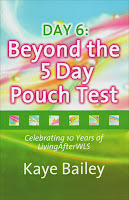Greetings Dear Readers!
The May LivingAfterWLS Inspired Reminders newsletter was published and delivered to your Inbox today. Be sure to check it out, it is full of useful information you need to know in your WLS journey. Here is the introduction and if you are not subscribed you can can read it here in our online archive: LivingAfterWLS May Inspired Reminders Bulletin
Link here to join our free mailing list: LivingAfterWLS Privacy Guaranteed Subscriber Form
It's not your imagination!
Your body is fighting against weight loss.
The chills & thrills of weight loss surgery.
In 2009 I wrote, "Ten years after being gut-whacked and I'm still on a diet." That is what I wanted to title my book which was eventually published as "Day 6: Beyond the 5 Day Pouch Test." In the introduction I explained, "No matter what treatment a person with the disease of morbid obesity seeks there is a tough journey to follow. There is no "easy way out." I am still on a diet. And it doesn't look to change anytime soon."
Jump forward to spring 2017: I'm 18-years removed from surgery and I'm still on a diet! I guess I'm in it for life. At one time this realization would have scared the jelly out of my doughnut. But these days it's my security blanket. I know I have a disease: obesity. I have been surgically treated for the disease. By following the prescribed lifestyle plan including diet and exercise I can work with my surgery to keep the disease in remission. That is the cold hard reality for all of us living after WLS. (See the article below Obesity Reclassified from 2013 when the AMA official categorized obesity a disease.)
Mind you, this acceptance was not easily achieved. I rebelled with vigor against the rules abandoning diet and physical activity in favor of hoping for the best. Leaving things to chance, however, did not help me control my obesity before surgery or after surgery. In our WLS community the path commonly trends to complete compliance following surgery followed by a detour along the road to chance and then, hopefully, a calm resolve of acceptance and renewed commitment to the lifestyle that supports our health and weight management goals. I've observed this trend for a decade and the anecdotal evidence predicts most patients will experience this learning curve.
Today's Bulletin features a look at why our body resists weight loss in the feature article It's not your imagination! Your body is fighting everything you do to lose weight. I found this subject revealing. I hope you enjoy it. As mentioned above you will find information about the 2013 obesity classification and also a primer Obesity Defined. Be sure to check out our Recipe: Tuna Pasta Primavera and then link through to some of the reader favorite Hot Blog Topics of the last few weeks.
I appreciate your time today, I know your Inbox is loaded with messages needing your attention. May I also take this opportunity to thank those who support our LivingAfterWLS Bookstore and other publication outlets. The LivingAfterWLS research work is self-funded and it is through your support that we are able to conduct clean research without becoming prejudiced by sponsors expecting a quid pro quo return of favorable findings in exchange for funding. Have a fabulous week and may good health be yours to enjoy!
Link to Bulletin
Kaye Bailey












